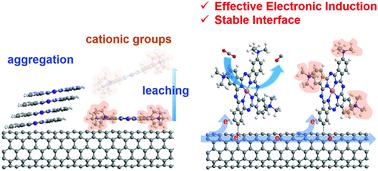当前位置:
X-MOL 学术
›
Energy Environ. Sci.
›
论文详情
Our official English website, www.x-mol.net, welcomes your
feedback! (Note: you will need to create a separate account there.)
Building a stable cationic molecule/electrode interface for highly efficient and durable CO2 reduction at an industrially relevant current
Energy & Environmental Science ( IF 32.4 ) Pub Date : 2020-12-8 , DOI: 10.1039/d0ee02535f Jianjun Su 1, 2, 3, 4 , Jun-Jie Zhang 5, 6, 7, 8 , Jiacheng Chen 4, 9, 10, 11 , Yun Song 1, 2, 3, 4 , Libei Huang 1, 2, 3, 4 , Minghui Zhu 4, 9, 10, 11 , Boris I. Yakobson 5, 6, 7, 8 , Ben Zhong Tang 1, 12, 13, 14, 15 , Ruquan Ye 1, 2, 3, 4, 16
Energy & Environmental Science ( IF 32.4 ) Pub Date : 2020-12-8 , DOI: 10.1039/d0ee02535f Jianjun Su 1, 2, 3, 4 , Jun-Jie Zhang 5, 6, 7, 8 , Jiacheng Chen 4, 9, 10, 11 , Yun Song 1, 2, 3, 4 , Libei Huang 1, 2, 3, 4 , Minghui Zhu 4, 9, 10, 11 , Boris I. Yakobson 5, 6, 7, 8 , Ben Zhong Tang 1, 12, 13, 14, 15 , Ruquan Ye 1, 2, 3, 4, 16
Affiliation

|
Aggregation and leaching are two major obstacles to the synthesis of efficient and durable heterogeneous molecular catalysts. These problems are even more severe for charged molecules, not only resulting in unsatisfactory performance, but also leading to misleading evaluation of charged functionalities. In this work, methylation of cobalt(II) tetraamino phthalocyanine (CoTAPc) transforms its electron-donating amino groups into electron-withdrawing quaternary ammonium cations, which favor the formation of *COOH intermediate and the desorption of *CO; this is conducive to a 130% increase of the current density for the CO2 reduction reaction (CO2RR). However, the catalysts leach severely; consequently, the current density decays rapidly. To resolve this dilemma, we developed an in situ functionalization strategy by first covalently grafting CoTAPc onto carbon nanotubes via a diazo-reaction, followed by a complete methylation reaction. This is conducive to a 700% increase in CO partial current density compared to that of a physically mixed sample at −0.72 V vs. RHE with highly stable currents. In a flow cell, this covalently immobilized structure delivers an industrially relevant current density of 239 mA cm−2, CO selectivity of 95.6% at 590 mV overpotential and very low molecular loading of 0.069 mg cm−2. This work provides mechanistic insight and a design strategy for charged molecular catalysts for high-performance and stable heterogeneous electrolysis.
中文翻译:

建立稳定的阳离子分子/电极界面,以在工业上相关的电流下高效,持久地减少二氧化碳
聚集和浸出是合成高效耐用的非均相分子催化剂的两个主要障碍。这些问题对于带电分子来说甚至更为严重,不仅导致性能不令人满意,而且还导致对带电官能度的误导性评估。在这项工作中,钴(II)四氨基酞菁(CoTAPc)的甲基化将其供电子氨基转变为吸电子季铵阳离子,这有利于* COOH中间体的形成和* CO的解吸;这有利于将CO 2还原反应(CO 2RR)。但是,催化剂严重浸出。因此,电流密度迅速衰减。为了解决这个难题,我们开发了一种原位功能化策略,首先通过重氮反应将CoTAPc共价接枝到碳纳米管上,然后进行完全的甲基化反应。与-0.72 V vs. RHE的物理混合样品相比,这具有较高的稳定电流,这有助于CO分流密度增加700%。在流通池中,这种共价固定的结构可提供239 mA cm -2的工业相关电流密度,在590 mV超电势下的CO选择性为95.6%和0.069 mg cm -2的非常低的分子负载。这项工作为高性能和稳定的多相电解带电分子催化剂提供了机械学的见解和设计策略。
更新日期:2020-12-24
中文翻译:

建立稳定的阳离子分子/电极界面,以在工业上相关的电流下高效,持久地减少二氧化碳
聚集和浸出是合成高效耐用的非均相分子催化剂的两个主要障碍。这些问题对于带电分子来说甚至更为严重,不仅导致性能不令人满意,而且还导致对带电官能度的误导性评估。在这项工作中,钴(II)四氨基酞菁(CoTAPc)的甲基化将其供电子氨基转变为吸电子季铵阳离子,这有利于* COOH中间体的形成和* CO的解吸;这有利于将CO 2还原反应(CO 2RR)。但是,催化剂严重浸出。因此,电流密度迅速衰减。为了解决这个难题,我们开发了一种原位功能化策略,首先通过重氮反应将CoTAPc共价接枝到碳纳米管上,然后进行完全的甲基化反应。与-0.72 V vs. RHE的物理混合样品相比,这具有较高的稳定电流,这有助于CO分流密度增加700%。在流通池中,这种共价固定的结构可提供239 mA cm -2的工业相关电流密度,在590 mV超电势下的CO选择性为95.6%和0.069 mg cm -2的非常低的分子负载。这项工作为高性能和稳定的多相电解带电分子催化剂提供了机械学的见解和设计策略。











































 京公网安备 11010802027423号
京公网安备 11010802027423号